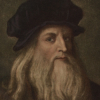Leonardo da Vinci

Leonardo da Vinci
Leonardo di ser Piero da Vinci, more commonly Leonardo da Vinci or simply Leonardoˈvintʃi] ; 15 April 1452 – 2 May 1519), was an Italian polymath whose areas of interest included invention, painting, sculpting, architecture, science, music, mathematics, engineering, literature, anatomy, geology, astronomy, botany, writing, history, and cartography. He has been variously called the father of paleontology, ichnology, and architecture, and is widely considered one of the greatest painters of all time. Sometimes credited with the inventions of the parachute, helicopter and tank,...
NationalityItalian
ProfessionPainter
Date of Birth15 April 1452
CityVinci, Italy
CountryItaly
A gray day provides the best light.
The light for drawing from nature should come from the North in order that it may not vary. And if you have it from the South, keep the window screened with cloth, so that with the sun shining the whole day the light may not vary. The height of the light so arranged as that every object shall cast a shadow on the ground of the same length as itself.
The vivacity and brightness of colors in a landscape will never bear any comparison with a landscape in nature when it is illumined by the sun, unless the painting is placed in such a position that it will receive the same light from the sun as does the landscape.
Shadows which you see with difficulty, and whose boundaries you cannot define... these you should not represent as finished or sharply defined, for the result would be that your work would seem wooden.
To any white body receiving the light from the sun, or the air, the shadows will be of a bluish cast.
There is no doubt that truth is to falsehood as light is to darkness; and so excellent a thing is truth that even when it touches humble and lowly matters, it still incomparably exceeds the uncertainty and falsehood in which great and elevated discourses are clothed; because even if falsehood be the fifth element of our minds, notwithstanding this, truth is the supreme nourishment of the higher intellects.
Shadow is the obstruction of light. Shadows appear to me to be of supreme importance in perspective, because, without them opaque and solid bodies will be ill defined; that which is contained within their outlines and their boundaries themselves will be ill-understood unless they are shown against a background of a different tone from themselves.
Shadow is the diminution alike of light and of darkness, and stands between darkness and light.
It is a far worthier thing to read by the light of experience than to adorn oneself with the labors of others.
After painting comes Sculpture, a very noble art, but one that does not in the execution require the same supreme ingenuity as the art of painting, since in two most important and difficult particulars, in foreshortening and in light and shade, for which the painter has to invent a process, sculpture is helped by nature. Moreover, Sculpture does not imitate color which the painter takes pains to attune so that the shadows accompany the lights.
A single and distinct luminous body causes stronger relief in the objects than a diffused light; as may be seen by comparing one side of a landscape illuminated by the sun, and one overshadowed by clouds, and illuminated only by the diffused light of the atmosphere.
The light and heat of the universe comes from the sun, and its cold and darkness from the withdrawal of the sun.
The first of all single colors is white ... We shall set down white for the representative of light, without which no color can be seen; yellow for the earth; green for water; blue for air; red for fire; and black for total darkness.
Darkness is absence of light. Shadow is diminution of light.